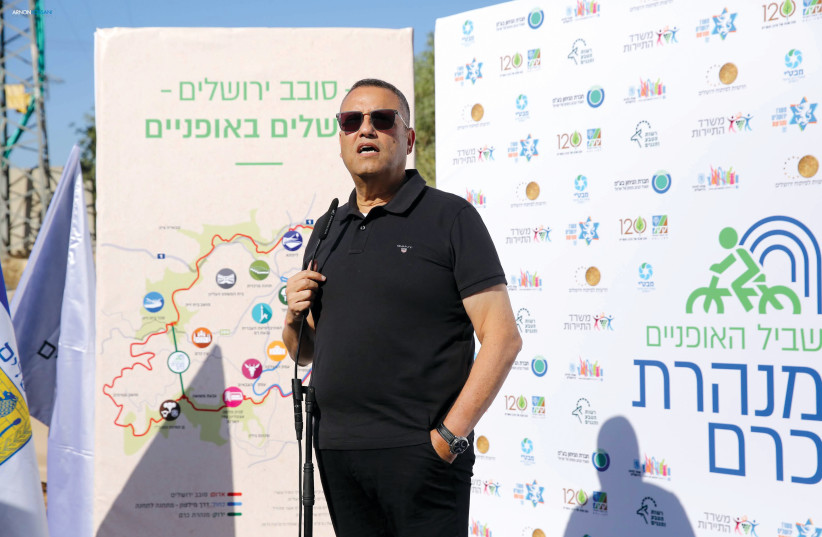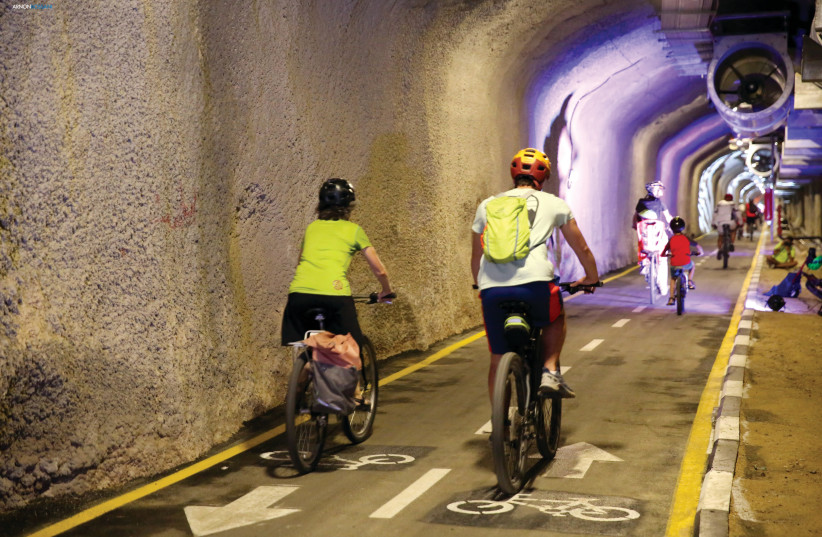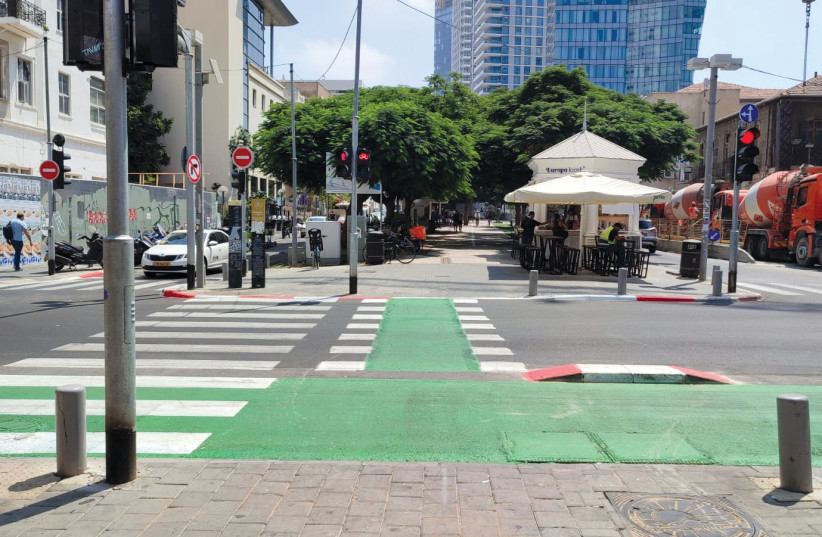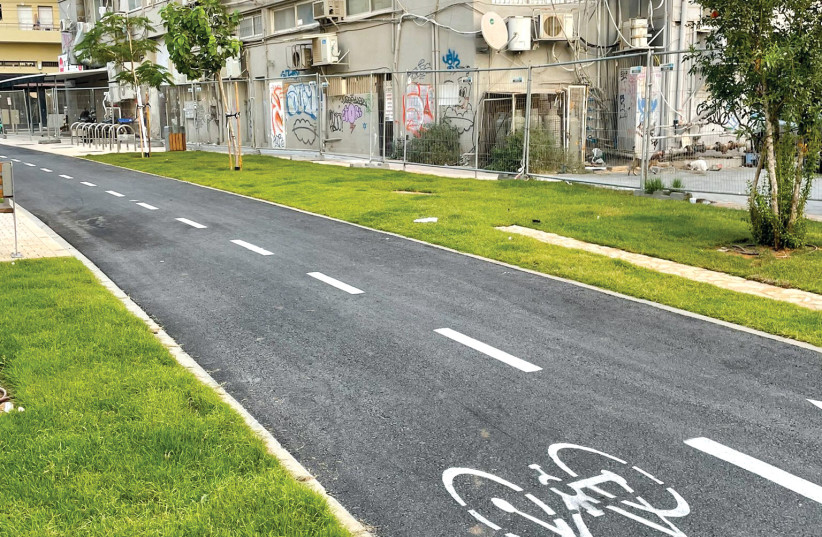Around four-and-a-half years ago, the Israeli cycling community was all abuzz. Thousands of road and mountain bikers learned that a previously unknown tunnel, used since the 1990s by the Hagihon water company that serves Jerusalem and its environs, had been reworked into a cycling route. And not just any old two-wheeler viaduct.
The grand opening ceremony took place at the start of the Jerusalem edition of Gran Fondo New York – aka GFNY – in 2018. GFNY is a major cycling event that now takes place in dozens of cities all over the world.
There was a beaming Nir Barkat, then mayor, at the entrance to the tunnel near the Jerusalem Zoo aquarium, cutting the ceremonial ribbon for the cameras. Hundreds of cyclists got to traverse the immaculately crafted subterranean route all the way down to Kerem Junction. We cyclists were all agog. At long last, the authorities-that-be had endowed us with a delightful treat, for our exclusive use. It was almost too good to be true. It was.
After sampling the unparalleled joy of riding in the tunnel – a full 2.1 km.-long, the-fifth longest in the world, we are told – I returned to the spot a few days later only to find the solid metal gate padlocked. After making inquiries with other cyclists, and with the Jerusalem Municipality, I was informed that the tunnel was not ready to be used on a permanent basis.

Why was the Jerusalem cycling tunnel closed off?
I fired off emails, spoke to municipal officials and wrote articles, but all to no avail. The most I could eke out of the officials was that a budget had yet to be procured in order to complete certain safety and other aspects of the tunnel.
I incredulously asked why, after pouring millions of our taxpayers’ hard-earned dough into the project, they hadn’t thought to cover the loose ends with another NIS 100,000 or so. No dice. At one point, I was told that they were trying to raise the wherewithal to fund the outline of the budget plan. If it hadn’t been so frustrating and pitiful, I’d have laughed out loud.
“All you get from despair is despair.”
Shimon Peres
But as late prime minister, president and holder of practically every ministerial position going Shimon Peres once said, “All you get from despair is despair.” The tunnel reopened for the 2019 edition of the GFNY, once again for just a few hours, and then COVID-19 came along and that was that for a couple of years.
Then, lo and behold, last Friday Mayor Moshe Lion acted out a reprise of the Barkat scene and declared the cycling tunnel open – and this time, it appears, for good. Hallelujah!
The advantages of using bicycles
With the advent of such a momentous occurrence, now seems as good a time as any to check out how we are doing, as a nation, to promote healthy, non-polluting modes of transport – particularly cycling.
WE ALL know the planet is heating up, and the quality of our air continues to deteriorate as ever-increasing numbers of vehicles clog our roads. And, while we are making some progress in producing more environmentally friendly cars and commercial vehicles, petroleum is still, by far, the major source of fuel.
One of the many lessons to be learned from the upheaval of the past couple of years is that we really should do our utmost to cut down on pollution, and also nurture our own health. Any virus, artificially engineered or the result of some natural evolution, will be more manageable on an individual basis if we take care of our immune system and, particularly, our respiratory organs. If that isn’t clear in the aftermath of the coronavirus, it never will be.
How far do Israeli cities have to go to being bicycle-friendly?
Cycling our way around town, instead of driving, can deliver on all the aforementioned fronts. But how cycle-friendly are our cities? How can we arrive at a situation in which adults, teenagers and kids can leave home and cycle, happily and safely, to school, work, the stores or even to a concert hall? Anyone who has visited major European cities, such as Amsterdam, Copenhagen or Vienna, will have seen user-friendly urban-wide cycling routes that enable locals to get around without jostling for room with motorized vehicles. It’s a win-win for all concerned.
At least for now, that still seems way off from where things stand in Jerusalem. While there has been significant progress in that area in the capital over the past decade or so, there is still a long way to go before we get close to where we really should be.
During a five-year sojourn in Baka, I saw the defunct train route, along Harekevet Street and beyond, gradually reimagined into Hamesila Park. A lovely cycle path was laid out, as was a dedicated route for walkers and runners atop the train tracks, with grass, trees and the odd fetching sculpture also installed. The enterprise was an instant success, as cyclists and runners proliferated in their hundreds.

Ruby Katz is not so sure. Katz, an ageless 67-year-old cycling enthusiast, feels the municipality might have done a better job. “You have the cycle path and the other side of the lawn, with the wooden plank platform for runners,” he says. “But it’s not wood. It’s concrete that looks like wood, and people who ran there said it wasn’t comfortable and that it damaged their knees.”
That doesn’t sound like the ideal running track. “So runners and walkers gravitated to the cycle path and, when I ride there, I have to wend my way along Harekevet Street. I have a bell on my bike but people run and walk with headphones on, and they don’t hear me. It’s very frustrating.”
Katz feels we are not particularly adept at keeping things ticking once we’ve set them up. “You have to make sure bicycle paths are in good serviceable condition. You can get encroaching vegetation and roots that create cracks in the tarmac, and that sort of thing.”
“You have to make sure bicycle paths are in good serviceable condition. You can get encroaching vegetation and roots that create cracks in the tarmac, and that sort of thing.”
Ruby Katz

YES, THERE have been mistakes made along the way.
A few years back, the municipality installed dedicated cycle routes in French Hill. The idea was to primarily encourage students who lived at the local dorms to bike their way to the university campus and back rather than using gas-guzzling vehicles. However, the paths were so poorly planned that they narrowed the road – not necessarily a bad thing in principle – so that at one point alongside parallel bus stops, the bus drivers had to fold in their side-view mirrors in order to squeeze by.
I got the sense that, however well-intentioned, if the people responsible for planning cycling infrastructure are not cyclists themselves, they may overlook such “technicalities.” They simply don’t have the street-level sensibilities. “We once had a deputy mayor who was a cyclist,” Katz notes. “We had a common language with him. Things worked well with him.”
Kobi Mamalia, head of the municipal Department of Transportation and Infrastructure Development, counters that gloomy perception. He says work is either underway or in the pipeline to get Jerusalemites away from their steering wheels and onto their handlebars. Mamalia says cycling infrastructure planning began in Jerusalem eight years ago, and that the pace picked up in 2019. “Over the past three years, since the new mayor came into office, a decision was made to extend the cycling network program,” he says.
“Over the past three years, since the new mayor came into office, a decision was made to extend the cycling network program.”
Kobi Mamalia
He adds this was a conscious move to improve environmentally friendly means of transport, and not just for leisure time use. “This is designed for commuting. The new plan features three path categories.” He noted “lengthwise” cycling highways, such as routes that are due to traverse the full length of Begin Road. Some sections already exist, such as the one that runs along Herzog Street from the Valley of the Cross down to the end of Gazelle Valley as far as Begin.
Mamalia cites a path that leads from Beit Safafa through Dov Yossef Street to Gilo; and there are plans to construct a route from Golomb Street northward, and along a biking route on Shmuel Bayit Street, part of which has been radically restructured to accommodate the new slip roads that feed Begin Road.
Considering the hullabaloo around Derech Hebron, where work on the light rail is due to begin – but without the cycling and walking routes, benches and green areas demanded by cycling activists and green bodies – it was encouraging to hear him mention the inclusion of bike lanes in the makeover stage.
We moved onto the sticky, crucial, matter of cycling continuity. Looking at the stretches of dedicated cycling tarmac around town, some with lovely dotted lines down the middle, there appears to be a conspicuous absence thereof. Near the corner of Chopin Street and Hanasi Street, for example, there is one “path” that runs for about six meters, followed by 20 or so meters of paved sidewalk before the bike path resumes for another approximately 15 meters. That is of little benefit to cyclists, while relieving the municipal budget of several thousand shekels.
Mamalia says the municipality has learned the lessons of past mistakes, such as the laughable biking route on either side of Henrietta Szold Street, which leads from the corner of Tahon Street in the direction of Mount Herzl. He lays the blame for that in other quarters. “That path was finished four years ago. It was built in accordance with Transportation Ministry guidelines,” he says. “Today we build paths that are two to three meters wide.”
The ministry is, of course, the ultimate authority and purse-string holder when it comes to cycling matters. When I raised the issue of bike boxes – designated safe areas for cyclists ahead of traffic lanes at intersections with traffic lights – Mamalia explained that ministerial approval is required for that too.

Tel Aviv is expanding bicycle paths much faster
MEANWHILE, IN Tel Aviv it looks like cycling-related matters happen at a very different pace and on a much grander scale. Whenever I bike over there from the Jerusalem Hills, I am always delighted to see the ever-increasing number of cycle paths spreading across the city. That, of course, encourages a concomitant volume of cyclists and electric-scooter users to make their way around town in generally healthy and fundamentally less polluting ways.
The folks over at the Tel Aviv-Jaffa Municipality seem to have a plan, and it appears to be coming together nicely. “We build around 20 km. a year of bicycle paths,” says Meital Lehavi, deputy mayor responsible for transportation affairs. “This year, a lot of that is feeder routes to the light rail. We want people using the light rail to be able to do the last mile of their journey by bike, on foot or by bus.”
“This year, a lot of that is feeder routes to the light rail. We want people using the light rail to be able to do the last mile of their journey by bike, on foot or by bus.”
Meital Lehavi
Construction of the tram system has been underway for some years now, naturally generating mobility challenges, but prominent green bike lanes continue to sprout nearby. The matter of feeder lanes is a salient one, considering the master plan for the Jerusalem light rail featured plans for such routes to encourage Jerusalemites to leave their cars behind, get on bikes, cycle to their nearest light rail stop and park the bikes there. That has yet to transpire on the Jerusalem commuting horizon. Perhaps it is still gestating in the grander urban scheme, but Tel Aviv appears to have a handle on the sequential cycling flow.
The benefits of green transportation
There are so many rewards offered by developing greener forms of transport, as noted in the Tel Aviv Municipality presentation. It states that public transport is “a key to social justice, narrowing [socioeconomic] gaps, equal opportunity for access to education, employment and leisure, leverage for environmental sustainability and quality of life, reducing air pollution, road congestion, [wasting] valuable time, accidents and human life.” That just about says it all.
It is often said that things really get going when we get hit in the pocket. The presentation places the financial cost of traffic jams, across the country, at NIS 35 billion a year, adding that sum will double by 2040 if we don’t do something about it now. The number of vehicles in Israel, apparently, shot up from 1.8 million in 2000 to 3 million in 2020, with 300,000 added thus far in 2022. Added to that, Israel now occupies seventh place in the global population density rankings, up from ninth in 2019, and we have the fourth highest birthrate in the world – highlighting the urgent need to make our urban transport systems more efficient and greener.

Lehavi is also keenly aware of the cycling route flow issue but says the municipality’s hands are tied by the ministerial overlords. “We can’t create cycling continuity at major junctions without the Transportation Ministry guidelines allowing us to do that, as per the layout of each individual junction,” she states. But, perhaps progress is in the offing on that score. “Just recently, we received approval to run pilot trials for just a few junctions, mostly with traffic lights. That doesn’t create full continuity, but we’ll see how that goes.”
When I cite various European cities as examples of how to go about facilitating cycling around town, Lehavi brings me back to the local street-level reality. “I also follow what they are doing around the world, but you can’t necessarily apply that to Israel,” she says. Once again, we are back to political, or policy, considerations. “That is not because of any adaptation problems. It is because the Transportation Ministry guidelines lay down the law.”
Ministerial obstacles notwithstanding, Mamalia is confident things in the capital are moving in the right direction. When I asked him if he thinks he and I can make a date five years hence to cycle the full length of Jerusalem, from Gilo in the south all the way to Neveh Ya’acov, he left no room for doubt.
“Absolutely,” he comes back at me. “And not in five years; it will be in four years. And we can stop for a coffee along the way.” Sounds good to me.
Mayor Moshe Lion is similarly optimistic. "Jerusalem is undergoing an infrastructure and transportation revolution," he says. "We are advancing measures designed to reduce private vehicle use and encourage a transition to public transport, the light rail, micromobility and walking.
"The bicycle paths we are building will connect neighborhoods with employment and leisure centers and will make the city more accessible. Today there is about 60 km. of paved bicycle paths, out of a planned around 200 km. Many sections are under construction, and the rest are at an advanced planning stage. We consider every detail and are making every effort to advance this work and make it efficient. Jerusalem is moving in a new, progressive and refreshing direction."
Let’s hope all the grand cycling route plans in Jerusalem, Tel Aviv and other urban centers come to fruition in the near future, and we can all breathe more easily. ❖
